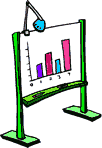
Grades 9-12

Don't have an account yet? Sign up for free
Don't have an account yet? Sign up for free


This lesson teaches students what economists mean when they talk about people who are employed, unemployed, and not in the labor force. It discusses the Current Population Survey and asks students to pose as government survey workers to determine the employment status of 10 people given in the lesson. Students also create a bar graph and a line graph to create a picture of the information they pretend to collect.
 Inform students that we all have jobs to do. They probably have some chores at home, like cleaning their room or setting the table. At school, they have jobs like finishing their work and copying this week’s spelling word list. These are important things for them to do. But according to economists, they are not working.
Inform students that we all have jobs to do. They probably have some chores at home, like cleaning their room or setting the table. At school, they have jobs like finishing their work and copying this week’s spelling word list. These are important things for them to do. But according to economists, they are not working.
Economists have a particular way of counting people who are and are not working. They want to know how many people over the age of 16 have jobs, how many don’t have jobs but want one, and how many don’t have jobs and aren’t looking for one.
When it comes to jobs in our country, our government and economists want to know about three important things:
When talking about these three things, economists use these words:
Although your students may not have heard these terms before, economists use them a lot. Talk with your students about what each one means.
Our government and economists say people are EMPLOYED if:
When people are employed, they are working for themselves or someone else and earning money for the work they do. "Employed" and "employment" are words that government officials and economists use when they talk about individuals who have jobs.
Government officials and economists say people are UNEMPLOYED if:

When individuals are unemployed, they are trying to find work so that they can earn money. "Unemployed" and "unemployment" are words government officials and economists use when they talk about people who don’t have jobs but want one. https://www.merriam-webster.com/ defines unemployed as: not employed: a) not being used b) not engaged in a gainful occupation c) not invested.
Now let’s talk about the word "labor." "Labor" is another word for work, and economists sometimes use it when they talk about jobs. For example, government officials and economists say people are NOT IN THE LABOR FORCE if:
When individuals are not in the labor force, they are part of a group of people who are not working and don't want to work right at that time.
 For example, if a student is going to college, she or he might not be working and might not want to work at that time, since work might interfere with school. Another example is someone who is retired. A retired person is someone who used to work, but doesn’t work anymore. People usually retire when they are older, after working for many years.
For example, if a student is going to college, she or he might not be working and might not want to work at that time, since work might interfere with school. Another example is someone who is retired. A retired person is someone who used to work, but doesn’t work anymore. People usually retire when they are older, after working for many years.
"Not in the labor force" is what government officials and economists call people who don’t have a job and don’t want one– like students and retired people.
All of this information is very important to economists. It’s so important that our government does a survey every month to find out how many people in our country are employed, unemployed, and not in the labor force. In fact, our government has been doing this survey, called the CURRENT POPULATION SURVEY every month since 1940.
[Note to teacher: You can read the https://www.bls.gov/cps/faq.htm from the Bureau of Labor Statistics for background information about unemployment and unemployment statistics. The https://www.bls.gov/cps/cps_htgm.htm also contains helpful information.]
Every month for this survey, government employees ask people in 60,000 homes a number of questions. The questions help our government decide how many people are employed, unemployed, and not in the labor force each month.
The government employees record the answers from the surveys into their computers and send the information to a main computer in Washington, D.C. The main computer analyzes the information and determines how many people are employed, unemployed, and not in the labor force. Our government then gives out the results to economists and other people who are interested in the information.
The survey results are so important that they usually are in the news every month. Luckily, anyone can use the Internet to see the results of the survey. Click the link at 'https://www.bls.gov/cps/ .' The Latest Numbers box shows information from the most recent survey. [Use the following examples to relate to this lesson: read the Change In Unemployment Level figure and explain that this is how many more (if positive number) or less (if negative number) people are unemployed compared to the month before. Do the same for the Change In Employment Level figure.]
 Economists are interested in how the survey numbers change over time. Find the heading that says Unemployment Rate. Click the dinosaur under this heading to see a https://data.bls.gov/timeseries/LNS14000000 . The graph shows the number of unemployed people in our country over the last 10 years. [Explain that the years are on the bottom of the graph, and the numbers on the left side are actually millions of people. For example, the number 7.3 is actually 7,300,000 people and the number 10 is actually 10,000,000 people. Sometimes graphs have shortened numbers to make them easier to read.]
Economists are interested in how the survey numbers change over time. Find the heading that says Unemployment Rate. Click the dinosaur under this heading to see a https://data.bls.gov/timeseries/LNS14000000 . The graph shows the number of unemployed people in our country over the last 10 years. [Explain that the years are on the bottom of the graph, and the numbers on the left side are actually millions of people. For example, the number 7.3 is actually 7,300,000 people and the number 10 is actually 10,000,000 people. Sometimes graphs have shortened numbers to make them easier to read.]
Below the graph, your students will see a listing of each year and the number of unemployed people. This is the same information also shown on the graph above it. [Ask the students which is easier to read and understand, the graph or the table?]
As your students know now, our government doesn’t survey millions of people or talk to everyone in the entire United States. That would take too long, and people would get tired of answering the same questions every month! STATISTICS along with studies about our country’s population enable government officials and economists to describe the employment situation for the whole country by using information from the Current Population Survey.
ACTIVITIES:

 From the information they sent to Washington D.C., a computer calculated this table of results for the number of unemployed people each month:
From the information they sent to Washington D.C., a computer calculated this table of results for the number of unemployed people each month:
| Month |
# Unemployed |
| January | 50 |
| February | 60 |
| March | 70 |
| April | 55 |
| May | 30 |
| June | 25 |
| July | 30 |
| August | 40 |
| September | 50 |
| October | 65 |
| November | 50 |
| December | 30 |
Have the students use the results to fill in a bar graph. Make sure they show the number of people unemployed from January through December.
[Ask the students to confirm whether they think it’s easier to quickly see how the numbers change over time using the graph or the table.]
In this lesson, students should have learned what economists and government officials mean when they talk about people who are employed, unemployed, and not in the labor force. They saw how the Current Population Survey provides information about people’s employment situation.
They learned that the Current Population Survey is very important, and that their government has done the survey every month since 1940. They have imagined they were survey workers collecting employment information, and they created graphs making the information they collected easier to read.
As they should have discovered, even though their jobs at home and school are important, economists don’t count them as working people!
Over the next week, have your students watch for and clip newspaper or magazine articles that talk about unemployment or new jobs. They should be looking for headlines that include the words “unemployment,” “employment,” “jobs,” “jobless,” and “labor.” Have them turn in their clippings to you so you may share them as topics for discussion in class.

Grades 9-12

Grades 9-12


Grades 9-12
